By Laura Di Orio of Dance Informa.
English National Ballet dancer Anjuli Hudson loves traveling and exploring London on her time off and even aspires to someday be a DJ. Wonderbound dancer Danny Ryan cherishes his time fly-fishing in Denver to “take a load off.” And Suzanne Farrell Ballet Soloist Violeta Angelova enjoys fashion, photography, writing and drawing. So what do these three (and many more!) dancers have in common? They all recognize the importance of life outside the dance studio and seek it out in their spare time.
Dance can be very time-consuming, with classes, rehearsals, performances and body maintenance, not to mention time to eat and sleep. Many dancers, however, as focused on dance as they can be during studio and stage time, have outside interests. These hobbies or activities allow them to unwind after a grueling day, de-stress after a long rehearsal and, perhaps, keep them grounded and well-rounded as people.
“To have outside interests makes your life richer, makes you more empathetic, gives you a better understanding of the world, broadens your social circle and countless other good things,” Angelova says.
And perhaps that makes these dancers better artists as well.
Hudson, too, agrees that a good balance between work life and outside life is important. She says she has a huge passion for music, enjoys studying psychology and loves boxed sets of TV shows. She also lives with friends outside of her dance circle, who don’t know a lot about ballet aside from what they see at her performances.
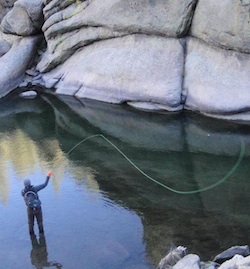
Wonderbound dancer Danny Ryan enjoys fly fishing in Denver during his time away from the studio. Photo by Juls Bicki.
“I love the fact that I can come home and chill out,” Hudson adds. “I think if it’s work, work, work all the time, it’s exhausting and can be unhealthy. I believe you have to be happy at home to be successful at work.”
Ryan, who was more a soccer player until his sophomore year in high school when he began to take dance seriously, de-stresses by being an avid fly fisherman.
“To me, there is nothing more relaxing than standing in a stream, practicing patience and watching nature,” Ryan says. “And more than anything, I think it is the watching nature part that is most therapeutic for me. Being able to leave the city and leave people and just be with my thoughts. That’s where I am most relaxed and find the most beauty in the world.”
Angelova says she, at one point, was fairly ballet-obsessed, with the majority of her thoughts revolving around ballet, but that has changed as she’s grown up.
“It seems anyone who’s thinking of making a serious career out of dance, or has made one, has been obsessed at one time or another, or enters and exits that state,” Angelova notes. “But it’s sad, I think, when people live 20, even 30 years, finding fulfillment only in dancing and then they have to retire and say that their life is over, that there is nothing after.”
To broaden her life, Angelova says she often works on non-dancing projects like writing and drawing in her spare time. She also enjoys fashion and photography, and she indulges in “non-productive” activities such as shopping, watching TV, surfing the Internet and flipping through magazines.
Outside interests like these may actually aid in, not deter from, a dancer’s inspiration, translating over to his/her art form as well.
“As I have grown, I have learned that finding interests that are removed from dance can be rejuvenating, rewarding and relaxing, not to mention inspiring,” Ryan says. “When it comes to my free time, I really try to get as far away from the dance world as possible, which, in turn, brings me closer to dance.”
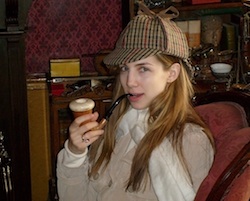
Ballerina Violeta Angelova, once a self-proclaimed ballet-obsessed dancer, now cherishes her free time by engaging in fashion, writing, photography and ‘non-productive’ activities. Photo courtesy of Violeta Angelova.
So how can dancers find other interests or learn to unwind outside of their time spent dancing?
“I think it can be difficult for dancers to break out of the ballet bubble and find other passions and interests outside of dance,” Hudson says. “Mainly because dance consumes so much of our time and dedication, we are left with little time to find other hobbies. My advice is to use your spare time wisely and try something new. Even if you’re not 100 percent interested in the first place, there’s no harm in feeding your curiosity!”
Finding a hobby outside of dance shouldn’t mean taking away from the dedication to the art form; rather, it means using spare time wisely for enjoyment and release.
“First and foremost, make sure your body is taken care of,” Angelova offers. “I used to love skiing, but then I got injured and had to stop. Similarly, spending extensive periods of time in the forest killing bears, going months without dance class, is not conducive to keeping the body in its dance-ready shape, which is kind of important for dancers.”
Ryan agrees that it may take some extra effort, but making the most of spare time could be very rewarding. “The best piece of advice I could give is this: no matter how tired you are from the week or the stage, it is always worth getting up and doing something for yourself,” he says. “At the end of the week, it pains me to think of getting up at four or five in the morning to drive somewhere to go fishing, but once Monday or Tuesday rolls around, you feel rested, inspired and fresh. Inspiration for what we do lies in who we are, and if we sacrifice ourselves on our time off we can be sacrificing our inspiration.”
Photo (top): On a day off, Anjuli Hudson and other members of English National Ballet participated in The Walk for Life to raise awareness for HIV and AIDS. Photo courtesy of Anjuli Hudson.


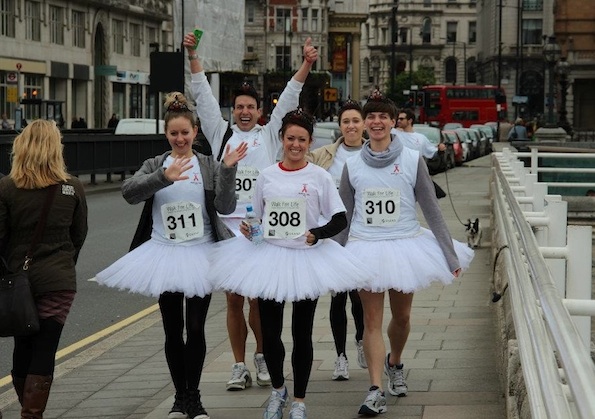





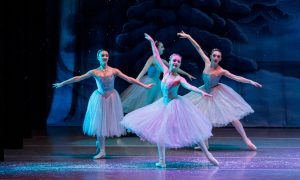





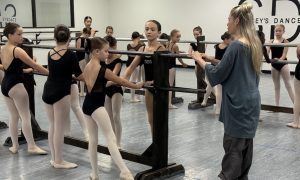

Pingback: Wonderbound: Junction Box – 1075 Park Avenue West | ArtPlace America